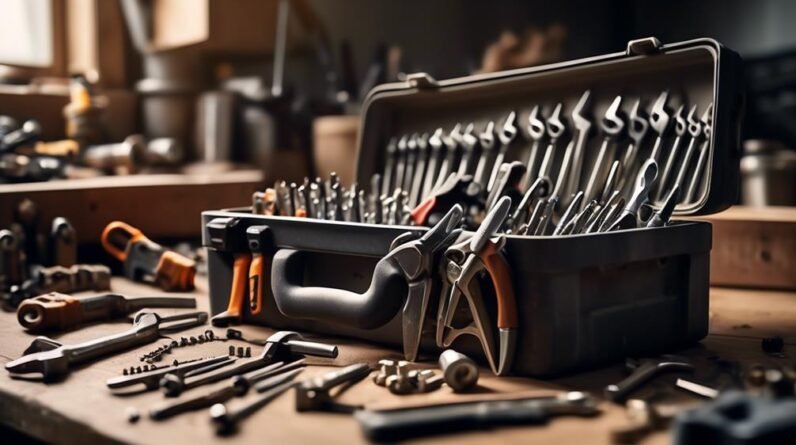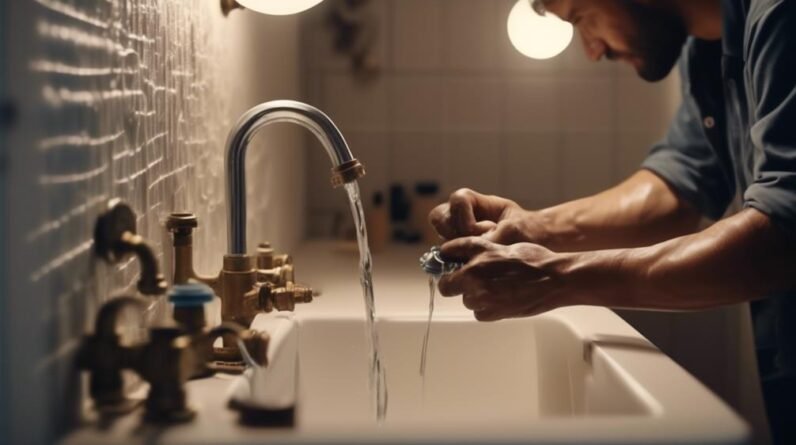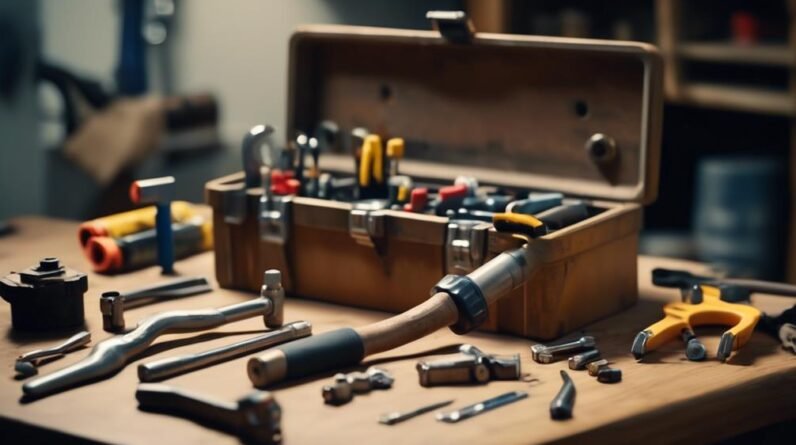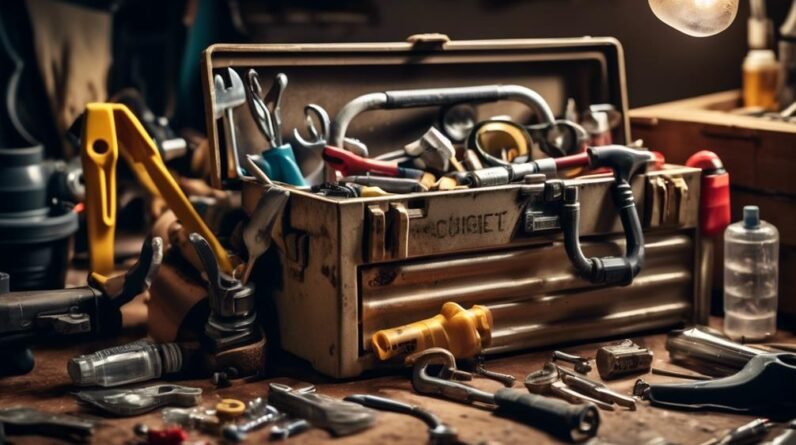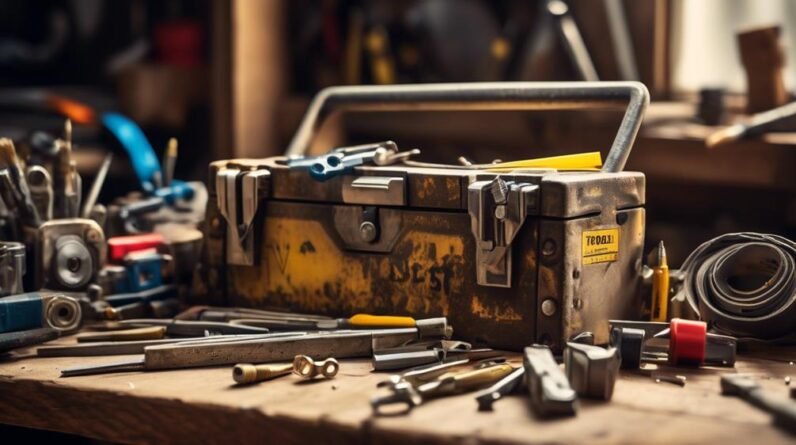
Imagine walking into a perfectly maintained home, where every corner boasts a touch of thrifty ingenuity. From the gleaming floors to the pristine walls, everything seems to be in its place, and you can't help but wonder how they do it. Well, wonder no more, because in this DIY guide, you'll discover a treasure trove of hacks for thrifty home maintenance that will transform your living space into a haven of frugal brilliance. From essential tools and budget-friendly cleaning hacks to energy-saving tips and DIY repairs, we've got you covered. And that's just the beginning. So, get ready to unlock the secrets of savvy home maintenance and unleash your inner DIY guru.
Key Takeaways
- Investing in essential tools and organizing them properly can make DIY home maintenance tasks much easier and efficient.
- Making your own natural homemade cleaners using pantry ingredients can be a cost-effective alternative to expensive commercial cleaners.
- Taking steps to save energy, such as investing in energy-efficient appliances and improving home insulation, can help reduce energy bills.
- Learning basic DIY repairs and fixes for common household problems can save money on hiring professionals and empower homeowners to tackle issues themselves.
Essential Tools for DIY Home Maintenance
To successfully tackle DIY home maintenance projects, you'll need a set of essential tools that will help you get the job done efficiently and effectively. But that doesn't mean you have to break the bank. There are budget-friendly tool alternatives that can still get the job done. When it comes to organizing your tool collection, here are some tips to keep in mind.
Firstly, consider investing in a toolbox or tool bag. This will not only keep your tools organized but also make them portable, allowing you to easily transport them to different areas of your home. Additionally, using a pegboard or a wall-mounted tool rack can help maximize your storage space while keeping your tools visible and easily accessible.
Secondly, categorize your tools. Separate them into different sections or compartments based on their function or size. This will make it easier for you to find the right tool when you need it, saving you time and frustration.
Lastly, label your tools. Use a marker or tape to label each tool or its designated spot in your toolbox or rack. This will help you quickly identify and return tools to their proper place after each use.
Budget-Friendly Cleaning Hacks
Save money on cleaning supplies with these budget-friendly hacks that will help you keep your home sparkling clean. Instead of splurging on expensive commercial cleaners, why not try making your own natural homemade cleaners? Not only are they effective, but they are also safe for you, your family, and the environment.
Here are three easy and affordable cleaning solutions that you can make using ingredients you probably already have in your pantry:
| Cleaning Solution | Ingredients | Instructions |
|---|---|---|
| All-Purpose Cleaner | 1 part white vinegar, 1 part water, lemon peel | Mix vinegar, water, and lemon peel in a spray bottle. Shake well before using. |
| Glass Cleaner | 2 cups water, 1/4 cup rubbing alcohol, 1/4 cup white vinegar, 1 tablespoon cornstarch | Combine all ingredients in a spray bottle. Shake well until the cornstarch is dissolved. |
| Bathroom Scrub | 1/2 cup baking soda, 1/4 cup liquid dish soap, 1/4 cup hydrogen peroxide | Mix all ingredients together to form a paste. Apply to surfaces and scrub with a sponge or brush. Rinse thoroughly. |
Simple Ways to Save on Energy Bills
If you're looking to cut down on your monthly expenses, one area where you can make a significant impact is by implementing simple and practical strategies to reduce your energy bills. Start by investing in energy efficient appliances. These appliances are designed to use less electricity or gas, resulting in lower energy consumption and reduced bills. Look for appliances with the Energy Star label, as these have been certified to meet strict energy efficiency standards.
Another effective way to save on energy bills is by improving your home's insulation. Proper insulation helps to keep warm or cool air inside your home, reducing the need for excessive heating or cooling. Start by checking for any drafts around windows and doors and sealing them with weatherstripping or caulk. You can also consider adding insulation to your attic, walls, and floors, as these areas are often responsible for significant heat loss.
Additionally, adjusting your thermostat can make a big difference in your energy consumption. Lowering the temperature in winter and raising it in summer by just a few degrees can result in significant energy savings. You can also consider installing a programmable thermostat that automatically adjusts the temperature based on your schedule.
DIY Repairs and Fixes for Common Household Problems
Get ready to tackle common household problems with these DIY repairs and fixes that will save you time, money, and the hassle of calling a professional. Here are four simple and effective ways to handle plumbing and electrical issues on your own:
- Fixing plumbing issues: Leaky faucets and clogged drains are common plumbing problems that can be easily fixed. Use a wrench to tighten any loose fittings on the faucet and replace worn-out washers to stop leaks. For clogged drains, try using a plunger or a mixture of baking soda and vinegar to break up the blockage.
- Repairing electrical problems: Electrical issues can be dangerous, so it's important to take precautions and turn off the power before attempting any repairs. If you're dealing with a tripped circuit breaker, simply reset it by flipping the switch back on. For a blown fuse, replace it with a new one of the same amperage. If you're unsure or uncomfortable with electrical work, it's best to consult a professional.
- Unclogging toilets: A clogged toilet can be a messy and unpleasant experience. Use a plunger to create suction and dislodge the blockage. If the plunger doesn't work, try using a toilet auger to break up the clog. Remember to use gloves and have a bucket handy to minimize any potential mess.
- Patching small holes in walls: Whether it's from hanging pictures or accidental damage, small holes in walls can be easily repaired. Use spackling paste or putty to fill the hole, smooth it out with a putty knife, and let it dry. Once dry, sand the area and apply a coat of paint to match the surrounding wall.
Creative Upcycling Ideas for Home Decor
Now that you've tackled DIY repairs and fixes for common household problems, it's time to explore creative upcycling ideas for home decor. Upcycling is a fantastic way to give new life to old items and reduce waste. One of the easiest ways to incorporate upcycled furniture into your home is by repurposing old pieces. For example, you can transform an old wooden ladder into a unique bookshelf or a vintage suitcase into a stylish side table. These repurposed home accessories not only add character to your space but also serve a practical purpose. Another idea is to turn empty glass bottles into beautiful vases or candle holders. Simply clean them out and add your favorite flowers or tea lights. If you're feeling crafty, you can even try your hand at creating your own artwork using reclaimed materials like old pallets or scrap wood. The possibilities are endless when it comes to upcycling, so get creative and let your imagination run wild.
Frequently Asked Questions
How Can I Effectively Clean My Carpets and Upholstery on a Budget?
Want budget-friendly carpet cleaning? Try DIY upholstery cleaning! Use baking soda to freshen up your carpets, then vacuum thoroughly. For upholstery, mix a solution of warm water and dish soap, and scrub gently.
What Are Some Easy Ways to Save on Water Usage in the Home?
Want to save on water usage? Start by investing in water-saving appliances and fixtures. Replace old toilets with low-flow models and install aerators on faucets. Simple tips like fixing leaks and taking shorter showers can also reduce water waste.
How Can I Fix a Leaky Faucet Without Calling a Plumber?
To fix a leaky faucet without calling a plumber, start by turning off the water supply. Then, use a wrench to loosen the faucet handle and replace the worn-out cartridge or O-ring. It's an easy DIY fix for plumbing issues.
What Are Some Creative Ways to Repurpose Old Furniture and Give It a New Life?
You can give old furniture a new life by repurposing it. Try upcycling ideas such as turning an old dresser into a kitchen island or transforming a wooden pallet into a stylish outdoor bench. Get creative with these DIY projects!
How Can I Save on Heating and Cooling Costs Without Sacrificing Comfort?
To save on heating and cooling costs without sacrificing comfort, try cost-effective insulation like weather stripping and caulk, and invest in an energy-efficient thermostat. These simple steps will help you maintain a comfortable home while saving money.
Conclusion
In conclusion, these DIY hacks for thrifty home maintenance provide practical and budget-friendly solutions for homeowners. By having essential tools on hand and utilizing simple cleaning hacks, you can keep your home clean and organized without breaking the bank. Additionally, implementing energy-saving techniques and DIY repairs can help reduce your monthly energy bills and fix common household problems. Lastly, incorporating creative upcycling ideas can add a unique touch to your home decor while also being environmentally friendly.


